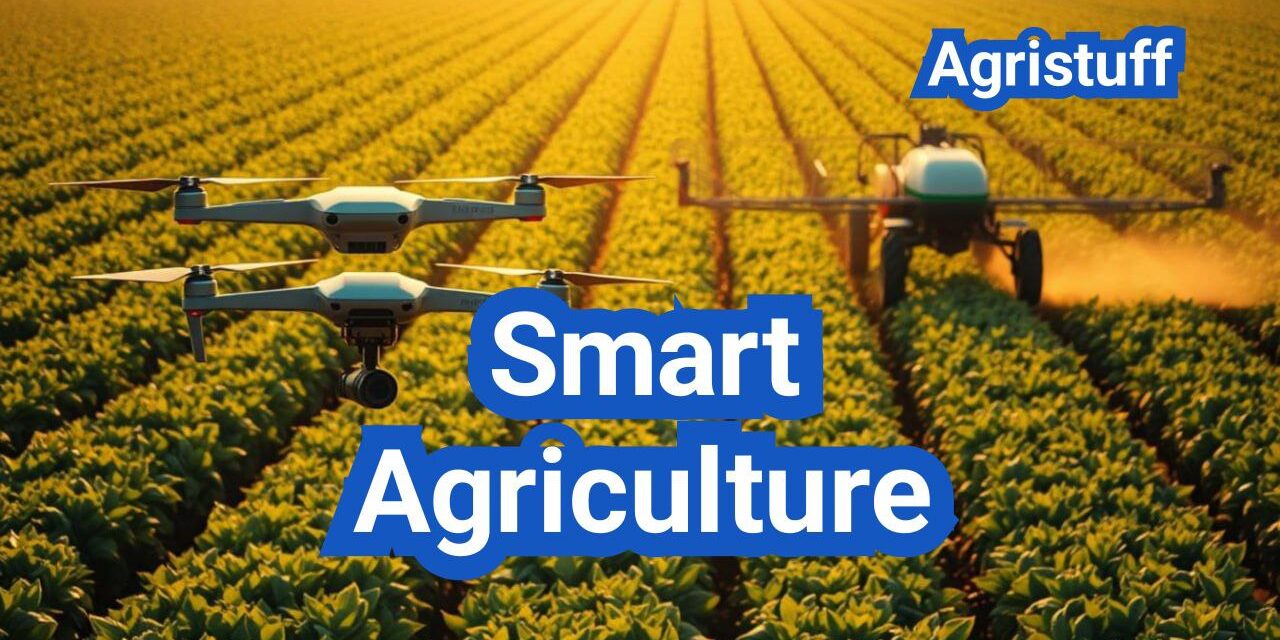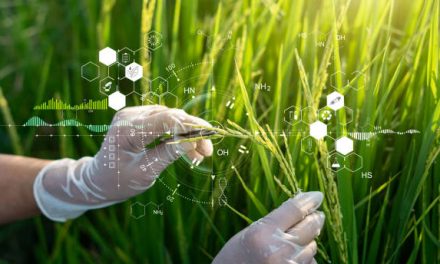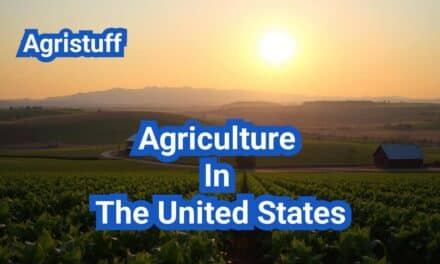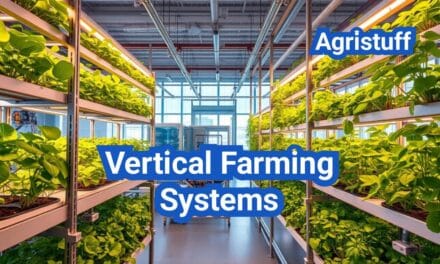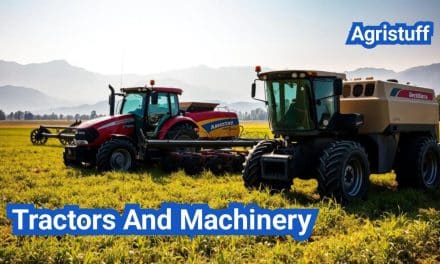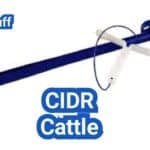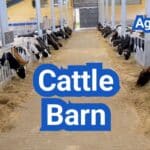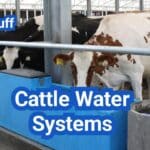The agricultural sector is undergoing a significant transformation with the advent of precision agriculture technology. By leveraging advanced technologies such as IoT sensors and data analytics, farmers can now make informed decisions to enhance agricultural production.
This shift towards smart farming practices is not just a trend; it’s a necessity driven by the need for sustainable and efficient farming methods. Farm management software plays a crucial role in this transformation, enabling farmers to streamline their operations and improve productivity.
Key Takeaways
- Precision agriculture technology is revolutionizing the farming industry.
- IoT sensors and data analytics are key drivers of this transformation.
- Farm management software is essential for efficient farm operations.
- Sustainable agriculture practices are becoming increasingly important.
- Smart agriculture is enhancing agricultural productivity and sustainability.
What Is Smart Agriculture: Core Concepts and Benefits
As the global population continues to grow, smart agriculture emerges as a vital solution, utilizing data-driven approaches to improve crop yields and reduce waste. Smart agriculture, also known as precision agriculture, involves the use of advanced technologies to enhance farming efficiency and productivity.
Definition and Fundamental Principles
Smart agriculture is defined by its integration of information and communication technologies (ICT) with farming practices. This includes the use of sensors, drones, GPS, and other IoT devices to collect and analyze data on soil moisture, temperature, crop health, and more. The fundamental principle behind smart agriculture is to make informed decisions based on real-time data, thereby optimizing resource allocation and minimizing environmental impact.
The Evolution from Traditional to Data-Driven Farming
Traditional farming methods often rely on historical practices and intuition. In contrast, smart agriculture represents a significant shift towards data-driven decision-making. By leveraging technologies like precision agriculture technology, farmers can now monitor and manage their crops more effectively, responding to changes in real-time and improving overall agricultural production.
Measurable Benefits for Agricultural Production
The adoption of smart agriculture practices has numerous measurable benefits, including increased crop yields, reduced water consumption, and lower input costs. Climate smart agriculture, a subset of smart agriculture, focuses on enhancing the resilience of farming systems to climate change. By adopting these practices, farmers can not only improve their productivity but also contribute to a more sustainable food system.
| Benefit | Description | Impact |
|---|---|---|
| Increased Crop Yields | Precision farming techniques allow for optimal growing conditions. | Higher productivity and better resource allocation. |
| Reduced Water Consumption | Advanced irrigation systems and soil moisture monitoring. | Conservation of water resources and lower costs. |
| Lower Input Costs | Targeted application of fertilizers and pesticides. | Reduced waste and environmental impact. |
By understanding the core concepts and benefits of smart agriculture, farmers and agricultural stakeholders can better appreciate the potential of these technologies to transform the agricultural sector.
Essential Components of a Smart Agriculture System

The effectiveness of a smart agriculture system depends on the seamless integration of its key components: hardware infrastructure, software solutions, and connectivity requirements. These elements work together to provide farmers with the data and insights needed to make informed decisions and optimize their farming practices.
Hardware Infrastructure: Sensors and Field Equipment
The hardware infrastructure is the backbone of any smart agriculture system, comprising various sensors and field equipment that collect critical data on soil moisture, temperature, crop health, and more. These devices are typically equipped with sensors that monitor environmental conditions, track equipment performance, and detect issues such as pests or diseases.
Key hardware components include:
- Soil moisture sensors to optimize irrigation
- Weather stations to monitor climatic conditions
- Crop health sensors to detect early signs of stress or disease
- GPS-guided equipment for precision farming
Software Solutions: Farm Management and Analytics Platforms
Software solutions play a crucial role in smart agriculture by providing a platform to manage, analyze, and interpret the vast amounts of data collected from the field. Farm management software helps farmers plan, monitor, and control their operations more effectively, while analytics platforms offer insights into trends and patterns that can inform future decisions.
Key features of farm management software include:
| Feature | Description | Benefit |
|---|---|---|
| Data Integration | Combines data from various sources | Provides a holistic view of farm operations |
| Analytics Tools | Analyzes data to identify trends and patterns | Enables data-driven decision-making |
| Task Management | Helps in planning and scheduling farm activities | Improves operational efficiency |
Connectivity Requirements: IoT Networks and Data Transmission
Connectivity is a critical component of smart agriculture, enabling the seamless transmission of data between devices, sensors, and the cloud or central management systems. IoT networks facilitate this connectivity, allowing for real-time monitoring and control of farm operations.
Key considerations for IoT networks in agriculture include:
- Reliability and stability of the network
- Range and coverage to ensure all areas of the farm are connected
- Security measures to protect against data breaches
- Scalability to accommodate additional devices as needed
Getting Started: Planning Your Smart Agriculture Project
Embarking on a smart agriculture project requires meticulous planning and a clear understanding of your farm’s specific needs. The initial phase is crucial for the success of the project, as it lays the groundwork for all subsequent steps.
Assessing Your Farm’s Specific Needs
The first step in planning your smart agriculture project is to conduct a thorough assessment of your farm’s current state. This involves evaluating your soil types, crop varieties, irrigation systems, and existing equipment. By understanding these factors, you can identify areas where precision agriculture technology can have the most significant impact.
For instance, farms with varied soil types may benefit from soil moisture sensors, while those with diverse crop varieties might require more sophisticated crop monitoring systems. This assessment will help you determine the most appropriate precision agriculture technology for your needs.
Setting Clear Objectives and Success Metrics
Once you have assessed your farm’s needs, the next step is to set clear objectives for your smart agriculture project. These objectives should be specific, measurable, achievable, relevant, and time-bound (SMART). Examples might include increasing crop yields by 15% within the next two growing seasons or reducing water consumption by 20% through more efficient irrigation management.
Establishing clear success metrics is equally important, as it allows you to track progress and make adjustments as needed. Common metrics include crop yield, water usage, input costs, and overall farm profitability.
Creating a Phased Implementation Roadmap
A phased implementation roadmap is essential for managing the complexity of a smart agriculture project. This involves breaking down the project into manageable stages, each with its own set of objectives and timelines.
A typical roadmap might include the following phases:
- Phase 1: Assessment and Planning
- Phase 2: Technology Selection and Procurement
- Phase 3: System Installation and Integration
- Phase 4: Training and Support
- Phase 5: Ongoing Monitoring and Optimization
| Phase | Key Activities | Timeline |
|---|---|---|
| Phase 1 | Assessment, objective setting | Weeks 1-4 |
| Phase 2 | Technology selection, procurement | Weeks 5-8 |
| Phase 3 | System installation, integration | Weeks 9-16 |
| Phase 4 | Training, support | Weeks 17-20 |
| Phase 5 | Ongoing monitoring, optimization | After Week 20 |
By following this structured approach, farmers can ensure that their smart agriculture project is well-planned, effectively executed, and ultimately successful in improving agricultural production.
Implementing Soil Monitoring Technologies
The implementation of soil monitoring technologies is a crucial step towards achieving precision agriculture. By leveraging these technologies, farmers can gain valuable insights into soil conditions, enabling them to make informed decisions that optimize crop yields and reduce waste.
Selecting and Deploying Soil Moisture Sensors
Soil moisture sensors are a fundamental component of soil monitoring technologies. These sensors measure the moisture levels in the soil, providing critical data for irrigation management. When selecting soil moisture sensors, farmers should consider factors such as accuracy, durability, and compatibility with existing farm equipment.
Key Considerations for Soil Moisture Sensors:
- Accuracy and reliability
- Compatibility with farm management software
- Durability and resistance to environmental factors
- Cost-effectiveness
Soil Health Analysis and Nutrient Management Tools
Soil health analysis is vital for understanding the nutrient content and overall condition of the soil. Advanced tools and technologies are available for analyzing soil health, including laboratory testing and on-site analysis kits. These tools help farmers identify nutrient deficiencies and develop targeted nutrient management plans.
Setting Up Variable Rate Application Systems
Variable Rate Application (VRA) systems enable farmers to apply inputs such as fertilizers and pesticides at varying rates across different parts of the field. This precision approach ensures that crops receive exactly what they need, reducing waste and environmental impact.
| Feature | Traditional Application | Variable Rate Application |
|---|---|---|
| Input Application | Uniform rate across the field | Varying rates based on soil conditions |
| Environmental Impact | Potential for over-application and waste | Reduced waste and environmental impact |
| Cost Efficiency | Potential for unnecessary input costs | Optimized input costs |
By implementing soil monitoring technologies, including soil moisture sensors, soil health analysis tools, and VRA systems, farmers can significantly enhance the efficiency and sustainability of their agricultural practices.
Deploying Smart Irrigation Solutions

Smart irrigation solutions are revolutionizing the way we manage water resources in agriculture. By leveraging advanced technologies, farmers can significantly reduce water waste and improve crop yields.
The deployment of smart irrigation systems involves several key components. Smart irrigation controllers are at the forefront of this technology, enabling farmers to make data-driven decisions about irrigation.
Installing Smart Irrigation Controllers
Installing smart irrigation controllers is a critical step in deploying smart irrigation solutions. These controllers can be integrated with various sensors and weather data sources to optimize irrigation schedules.
- Soil moisture sensors provide real-time data on soil conditions.
- Weather stations offer forecasts and current weather conditions.
- Flow meters monitor water usage, helping to detect leaks or anomalies.
By integrating these components, farmers can create a comprehensive irrigation management system.
Configuring Evapotranspiration Irrigation Scheduling
Evapotranspiration (ET) irrigation scheduling is a method that calculates the water needs of crops based on environmental factors. This approach ensures that crops receive the right amount of water at the right time.
To configure ET irrigation scheduling, farmers need to:
- Determine the ET rate for their specific crops and region.
- Adjust irrigation schedules based on ET data and soil moisture levels.
- Continuously monitor weather forecasts to anticipate changes in ET rates.
This data-driven approach helps in optimizing water use and reducing waste.
Optimizing Water Usage Through Precision Technologies
Precision technologies play a vital role in optimizing water usage in agriculture. By using advanced irrigation management systems, farmers can achieve significant water savings.
Some key strategies include:
- Using variable rate irrigation (VRI) to apply water at the right rate across the field.
- Implementing precision irrigation scheduling based on real-time data.
- Leveraging data analytics to identify areas of inefficiency.
By adopting these strategies, farmers can not only conserve water but also improve the overall health and productivity of their crops.
Leveraging Drone and Imaging Technologies
Precision agriculture has taken a significant leap forward with the advent of drone imagery and NDVI analysis. This technology enables farmers to monitor crop health, detect issues early, and make data-driven decisions to improve yields.
Implementing Drone Imagery and NDVI Analysis
Drone imagery involves capturing high-resolution images of crops using specialized cameras mounted on drones. NDVI (Normalized Difference Vegetation Index) analysis is a technique used to assess crop health by measuring the difference between near-infrared and visible light reflected by plants.
Benefits of NDVI Analysis:
- Early detection of crop stress and disease
- Improved crop monitoring and management
- Enhanced decision-making for irrigation and fertilization
Utilizing Satellite Imaging for Large-Scale Monitoring
Satellite imaging offers a broader perspective for large-scale agricultural monitoring. Satellites can capture images of vast areas, providing insights into crop health, growth patterns, and potential issues.
| Feature | Drone Imagery | Satellite Imaging |
|---|---|---|
| Resolution | High-resolution images (up to a few cm/pixel) | Variable resolution (from a few m/pixel to cm/pixel) |
| Coverage Area | Limited to a few hundred acres per flight | Can cover large areas, even entire countries |
| Frequency of Data | Can be flown as frequently as needed | Dependent on satellite orbit and revisit time |
Processing and Interpreting Agricultural Imagery Data
Processing and interpreting imagery data require specialized software and expertise. Farmers can use this data to identify trends, detect anomalies, and make informed decisions.
Key Steps in Data Interpretation:
- Data Collection: Gathering imagery data from drones or satellites
- Data Processing: Using software to correct and analyze the data
- Data Interpretation: Identifying insights and trends in the processed data
- Decision Making: Using insights to inform agricultural practices
Selecting and Implementing Farm Management Software
Farm management software plays a vital role in optimizing agricultural production through data-driven operations. As the agricultural sector continues to embrace technology, the importance of selecting the right farm management software cannot be overstated.
The process of implementing farm management software involves several critical steps, starting with the evaluation of comprehensive management platforms. These platforms serve as the backbone of modern farm operations, integrating various aspects of farm management into a single, cohesive system.
Evaluating Comprehensive Management Platforms
When evaluating farm management software, it’s essential to consider the scope of features and functionalities offered. A comprehensive platform should include tools for crop management, financial management, and operational planning.
- Crop management: tracking crop health, growth stages, and yield predictions
- Financial management: budgeting, expense tracking, and revenue analysis
- Operational planning: scheduling, task management, and resource allocation
A robust farm management software should also offer scalability to accommodate the growing needs of the farm and integration capabilities with other precision agriculture technologies.
Setting Up Mobile Applications for Field Operations
Mobile applications are a crucial component of modern farm management software, enabling farmers to conduct field operations more efficiently. These applications allow for real-time data collection, task management, and instant communication with the farm management team.
Key features of mobile applications for farm management include:
- Data collection: capturing field data such as soil conditions, crop health, and weather observations
- Task management: assigning and tracking tasks for farm workers
- Real-time reporting: generating reports on field operations and conditions
Integrating Data Sources for Decision Support
One of the most significant advantages of farm management software is its ability to integrate data from various sources, providing a holistic view of farm operations. This integration enables farmers to make informed decisions based on comprehensive data analysis.
Data sources that can be integrated into farm management software include:
| Data Source | Description | Benefits |
|---|---|---|
| Soil Sensors | Provide real-time data on soil moisture, temperature, and nutrient levels | Optimized irrigation and fertilization |
| Weather Stations | Offer current and forecasted weather conditions | Improved planning for planting, spraying, and harvesting |
| Satellite Imagery | Deliver high-resolution images of crop health and field conditions | Early detection of issues, targeted interventions |
By integrating these data sources, farm management software provides a powerful decision-support tool, enabling farmers to optimize their operations and improve agricultural production.
Smart Agriculture Using IoT: Implementation Steps

Implementing smart agriculture using IoT requires a comprehensive approach that starts with designing an effective IoT sensor network. This foundational step is crucial for collecting accurate data that will inform farming decisions.
Designing Your IoT Sensor Network
The first step in implementing smart agriculture using IoT is to design a robust IoT sensor network. This involves selecting the right sensors for monitoring soil moisture, temperature, and other critical parameters. Precision agriculture technology relies heavily on these sensors to provide real-time data.
When designing your IoT sensor network, consider the layout of your farm and the specific needs of your crops. This will help you determine the optimal placement of sensors to ensure comprehensive coverage.
Establishing Reliable Data Collection Protocols
Once your IoT sensor network is in place, the next step is to establish reliable data collection protocols. This involves configuring your sensors to transmit data to a central platform where it can be analyzed. Reliable data collection is essential for making informed decisions in smart agriculture.
Data collection protocols should be designed to ensure that data is transmitted securely and efficiently. This may involve using wireless communication protocols and ensuring that your network is protected against potential cyber threats.
Creating Automated Alert and Response Systems
An integral part of smart agriculture using IoT is the creation of automated alert and response systems. These systems use the data collected from your IoT sensor network to trigger alerts when certain conditions are met, such as when soil moisture levels drop below a certain threshold.
By automating the response to these alerts, farmers can take timely action to address issues before they become major problems. This not only improves agricultural production but also reduces the need for manual intervention.
In conclusion, implementing smart agriculture using IoT involves several key steps, from designing an IoT sensor network to creating automated alert and response systems. By following these steps, farmers can harness the power of precision agriculture technology to improve their yields and reduce their environmental impact.
Building Smart Livestock Management Systems
Smart livestock farming is revolutionizing the agricultural industry by integrating advanced technologies to improve animal welfare and productivity. This transformation is driven by the need for more efficient, sustainable, and humane farming practices.
Implementing Animal Monitoring and Health Tracking
One of the core components of smart livestock management is the implementation of animal monitoring and health tracking systems. These systems utilize sensors and IoT devices to monitor the health, behavior, and location of livestock in real-time.
Key benefits include:
- Early detection of illness or distress
- Improved breeding and reproduction management
- Enhanced animal welfare
- Reduced labor costs through automation
Setting Up Automated Feeding and Care Systems
Automated feeding and care systems are another crucial aspect of smart livestock management. These systems use precision agriculture technology to optimize feeding schedules, nutrient delivery, and overall care for the animals.
| System Component | Functionality | Benefits |
|---|---|---|
| Automated Feeders | Dispense feed according to schedule or animal needs | Reduced waste, improved nutrition |
| Health Monitoring Sensors | Track animal health and behavior | Early detection of health issues |
| Environmental Control Systems | Regulate temperature, humidity, and ventilation | Improved animal comfort and health |
Optimizing Livestock Environment Control
Optimizing the environment in which livestock are raised is critical for their health and productivity. Smart livestock management systems include advanced climate control and ventilation systems that adjust to the needs of the animals.
By integrating these technologies, farmers can create a more sustainable and productive farming operation. As the agricultural industry continues to evolve, the adoption of smart livestock management systems is expected to play a significant role in meeting the world’s growing food demands.
Developing Controlled Environment Agriculture Solutions

Smart greenhouses and vertical farming systems are at the forefront of controlled environment agriculture, offering precise control over growing conditions. These systems enable farmers to optimize crop growth, reduce waste, and promote sustainable agricultural practices.
Designing Smart Greenhouses and Vertical Farming Systems
Designing effective controlled environment agriculture systems requires careful planning and integration of various technologies. Smart greenhouses utilize advanced materials and climate control systems to create optimal growing conditions. Vertical farming systems, on the other hand, stack layers of crops in a controlled environment, maximizing space and reducing land use.
Key considerations for designing these systems include:
- Climate control and monitoring
- Lighting systems tailored to crop needs
- Water management and conservation
- Integration of automation and robotics
Implementing Automated Climate Control Technologies
Automated climate control is crucial in controlled environment agriculture, ensuring that crops are grown in optimal conditions. This involves the use of sensors to monitor temperature, humidity, and light levels, and automated systems to adjust these parameters as needed.
The benefits of automated climate control include improved crop yields, reduced energy consumption, and enhanced resilience to weather fluctuations.
| Technology | Function | Benefits |
|---|---|---|
| Temperature Control Systems | Maintains optimal temperature for crop growth | Improved crop yields, reduced stress |
| Humidity Management | Regulates humidity levels to prevent disease | Reduced risk of fungal diseases, improved air quality |
| LED Grow Lights | Provides tailored lighting for crop needs | Enhanced growth rates, energy efficiency |
Integrating Plant Care Automation Tools
Integrating plant care automation tools is essential for maximizing efficiency and productivity in controlled environment agriculture. These tools can include automated watering systems, pruning robots, and monitoring systems for crop health.
By leveraging these technologies, farmers can reduce labor costs, improve crop quality, and increase overall yields. The integration of automation tools also enables real-time monitoring and data collection, allowing for data-driven decision-making.
Harnessing AI in Agriculture: Practical Applications
Precision agriculture is being taken to the next level with the application of AI, enabling farmers to make data-driven decisions. This section explores the practical applications of AI in agriculture, focusing on how these technologies are transforming farming practices.
Implementing Predictive Analytics for Crop Management
Predictive analytics is a crucial AI application in agriculture, allowing farmers to forecast crop yields, detect potential issues early, and optimize farming practices. By analyzing historical data, weather patterns, and soil conditions, predictive models can provide insights into the best planting times, fertilizer applications, and harvesting schedules.
For instance, predictive analytics can help farmers determine the optimal time for planting based on soil moisture levels and weather forecasts, thereby improving crop yields. Additionally, these analytics can predict potential pest and disease outbreaks, enabling proactive measures to mitigate risks.
Deploying Machine Learning for Pest and Disease Detection
Machine learning algorithms are being deployed to detect pests and diseases in crops more accurately and earlier than traditional methods. By analyzing images captured by drones or satellite imagery, these algorithms can identify issues that are not visible to the naked eye.
For example, a machine learning model trained on a dataset of images of healthy and diseased crops can be used to detect early signs of disease in new images. This enables farmers to take targeted action, reducing the use of chemical pesticides and maintaining crop health.
Setting Up AI-Powered Decision Support Systems
AI-powered decision support systems are being increasingly adopted in agriculture to provide farmers with actionable insights and recommendations. These systems integrate data from various sources, including sensors, drones, and weather stations, to offer a comprehensive view of farm operations.
The following table illustrates the components and benefits of AI-powered decision support systems in agriculture:
| Component | Functionality | Benefits |
|---|---|---|
| Data Integration | Combines data from sensors, drones, and weather stations | Provides a holistic view of farm operations |
| Predictive Analytics | Forecasts crop yields, weather patterns, and potential issues | Enables proactive decision-making |
| Machine Learning | Analyzes data to identify patterns and insights | Improves accuracy of predictions and recommendations |
By harnessing AI in agriculture, farmers can not only improve the efficiency and productivity of their operations but also contribute to sustainable farming practices.
Establishing Robust Agricultural Connectivity

As agriculture becomes increasingly digitized, the need for robust connectivity solutions has never been more pressing. Reliable agricultural connectivity is the foundation upon which modern farming operations are optimized, enabling the seamless integration of advanced technologies such as precision agriculture and remote monitoring systems.
Agricultural Broadband Solutions
Implementing agricultural broadband solutions is crucial for providing the high-speed internet connectivity required for data-intensive farming applications. This involves assessing the farm’s current internet infrastructure and upgrading it to support faster data transfer rates. Rural broadband initiatives have been instrumental in expanding internet access to previously underserved agricultural areas.
The choice of broadband technology—whether it be fiber, cellular, or satellite—depends on the farm’s location, size, and specific needs. For instance, farms in remote areas may rely on satellite internet due to the lack of cellular or fiber infrastructure.
Ensuring ISOBUS Compatibility
ISOBUS compatibility is essential for ensuring that different pieces of farm equipment can communicate effectively with each other and with farm management software. This compatibility is achieved through adherence to the ISO 11783 standard, which defines the protocol for communication between agricultural equipment.
By ensuring ISOBUS compatibility, farmers can integrate equipment from various manufacturers, creating a more cohesive and efficient farming operation. This interoperability is key to unlocking the full potential of precision agriculture technologies.
| Equipment Type | ISOBUS Compatibility | Benefits |
|---|---|---|
| Farm Tractors | Yes | Improved precision and control |
| Plows | Yes | Enhanced compatibility with tractors |
| Planters | Yes | Optimized planting precision |
Building Reliable Remote Monitoring Infrastructure
Remote monitoring is a critical component of modern agricultural operations, allowing farmers to monitor and manage their farms in real-time, regardless of their physical location. Building a reliable remote monitoring infrastructure involves deploying sensors and IoT devices that can collect and transmit data on various farm parameters.
This infrastructure must be supported by robust connectivity solutions to ensure that data is transmitted reliably and in a timely manner. By leveraging remote monitoring, farmers can respond quickly to changes in weather conditions, soil moisture levels, and crop health, thereby optimizing their farming practices.
Implementing Climate Smart Agriculture Practices

The integration of climate-smart practices in agriculture is crucial for enhancing resilience and productivity. As climate change continues to impact agricultural productivity, farmers and agricultural stakeholders are turning to climate-smart agriculture (CSA) as a viable solution.
Adopting Sustainable Farming Technologies
Sustainable farming technologies play a pivotal role in climate-smart agriculture. These technologies include precision agriculture tools, such as GPS-guided equipment and drones, which help in optimizing the use of resources like water and fertilizers. By adopting such technologies, farmers can reduce their environmental footprint while maintaining or even increasing crop yields.
Precision agriculture involves the use of advanced technology to optimize field-level management regarding crop farming. It includes collecting data on soil types, weather patterns, and crop health, which is then used to make informed decisions about planting, irrigation, and harvesting.
Implementing Carbon Footprint Reduction Strategies
Reducing the carbon footprint of agricultural activities is a critical component of climate-smart agriculture. Strategies for carbon footprint reduction include the use of renewable energy sources, such as solar and wind power, to energize farm operations. Additionally, practices like conservation tillage and cover cropping can help sequester carbon in soils.
- Promoting the use of energy-efficient farm equipment
- Implementing regenerative agriculture practices
- Enhancing soil health through organic amendments
Building Resilience Through Smart Climate Adaptation
Building resilience to climate change involves adapting farming practices to the anticipated impacts of climate change, such as increased frequency of extreme weather events. This can be achieved through the use of climate-resilient crop and animal varieties, as well as through the implementation of early warning systems for weather events.
Climate-resilient agriculture focuses on improving the resilience of farming systems to climate change by enhancing the ability of farmers to adapt to changing conditions. This includes practices such as agroforestry and the use of climate-tolerant crop varieties.
By implementing these climate-smart agriculture practices, farmers can not only reduce their environmental impact but also improve their productivity and resilience in the face of climate change.
Creating a Smart Agriculture Working Model
Developing a smart agriculture working model requires a strategic approach, starting with small-scale pilot projects. This initial step allows farmers to test and refine their smart agriculture systems before scaling up.
Developing Small-Scale Pilot Projects
Pilot projects are crucial for identifying potential issues and opportunities in smart agriculture implementations. By starting small, farmers can assess the effectiveness of precision agriculture technology in their specific operational context.
These pilot projects should focus on specific aspects of smart agriculture, such as soil monitoring or smart irrigation systems. This targeted approach enables farmers to gather valuable data on the performance of these technologies.
Scaling Successful Technologies Farm-Wide
Once pilot projects have demonstrated success, the next step is to scale these technologies across the farm. This involves integrating the insights gained from the pilot projects into a broader data-driven farm operations strategy.
Scaling up requires careful planning to ensure that the infrastructure can support the expanded system. This may involve upgrading hardware, enhancing data analytics capabilities, and training staff to manage the new technologies effectively.
Measuring and Optimizing System Performance
Continuous monitoring and evaluation are essential for optimizing the performance of smart agriculture systems. By tracking key performance indicators related to agricultural production, farmers can identify areas for improvement.
Regular analysis of system performance data allows for adjustments to be made, ensuring that the smart agriculture working model remains effective and efficient over time. This iterative process of measurement and optimization is crucial for maximizing the benefits of smart agriculture technologies.
Measuring ROI and Performance of Smart Farming Initiatives
Smart farming’s true potential is unlocked when farmers can effectively measure the ROI of their technological investments. This measurement is crucial not only for justifying the costs associated with adopting new technologies but also for guiding future agricultural practices.
Tracking Key Performance Indicators
To accurately measure the ROI of smart farming initiatives, farmers must track relevant key performance indicators (KPIs). These may include crop yield improvements, reductions in water and fertilizer usage, and enhanced operational efficiency. By monitoring these KPIs, farmers can gain insights into the effectiveness of their smart farming practices.
Essential KPIs for Smart Farming:
- Crop yield per acre
- Water consumption rates
- Fertilizer and pesticide application rates
- Operational labor hours
- Equipment maintenance costs
Conducting Comprehensive Cost-Benefit Analysis
A thorough cost-benefit analysis is vital for understanding the financial implications of smart farming technologies. This involves calculating both the direct and indirect costs associated with implementing these technologies, as well as the benefits they bring, such as increased productivity and reduced waste.
Steps for a Comprehensive Cost-Benefit Analysis:
- Identify all costs associated with the smart farming technology
- Quantify the benefits, both tangible and intangible
- Compare the total costs with the total benefits
- Consider the long-term implications and potential scalability
Adjusting Systems Based on Performance Data
The true value of smart farming lies in its ability to inform decision-making through data. By analyzing performance data, farmers can identify areas for improvement and adjust their systems accordingly. This might involve fine-tuning irrigation schedules, adjusting fertilizer application rates, or modifying crop rotation patterns.
Data-Driven Adjustments:
| Performance Metric | Data Analysis | System Adjustment |
|---|---|---|
| Crop Yield | Identify yield patterns and anomalies | Adjust fertilizer and irrigation strategies |
| Water Usage | Analyze consumption patterns | Optimize irrigation scheduling |
Embracing the Future of Smart Agriculture
The future of smart agriculture is poised to revolutionize the agricultural sector through the adoption of advanced technologies and sustainable practices. Precision agriculture technology is at the forefront of this transformation, enabling farmers to optimize crop yields, reduce waste, and promote sustainable farming methods.
As the global population continues to grow, the need for efficient and sustainable agricultural production methods becomes increasingly important. Smart agriculture offers a solution by leveraging data-driven insights to improve decision-making and resource allocation.
By embracing smart agriculture, farmers can not only enhance their productivity but also contribute to a more sustainable food system. The integration of precision agriculture technology and sustainable farming practices will be crucial in shaping the future of agriculture.
As we move forward, it is essential to continue investing in smart agriculture technologies and promoting their adoption among farmers. By doing so, we can ensure a more sustainable and productive agricultural sector, ultimately benefiting both the environment and the global community.
FAQ
What is smart agriculture?
Smart agriculture refers to the use of advanced technologies, such as IoT sensors, drones, and AI-powered analytics, to improve agricultural productivity, efficiency, and sustainability.
What are the benefits of smart agriculture?
The benefits of smart agriculture include increased crop yields, reduced water and fertilizer usage, improved crop quality, and enhanced decision-making capabilities through data-driven insights.
What are the essential components of a smart agriculture system?
The essential components of a smart agriculture system include hardware infrastructure such as sensors and field equipment, software solutions like farm management and analytics platforms, and connectivity requirements for IoT networks and data transmission.
How do I plan a smart agriculture project?
To plan a smart agriculture project, assess your farm’s specific needs, set clear objectives and success metrics, and create a phased implementation roadmap.
What is the role of IoT in smart agriculture?
IoT plays a crucial role in smart agriculture by enabling the collection and transmission of data from sensors and other devices, facilitating real-time monitoring and decision-making.
How can drone technology be used in agriculture?
Drone technology can be used in agriculture for crop monitoring, soil analysis, and crop spraying, among other applications, providing valuable insights and improving efficiency.
What is climate smart agriculture?
Climate smart agriculture refers to the use of agricultural practices and technologies that help farmers adapt to climate change, improve resilience, and reduce greenhouse gas emissions.
How can AI be used in agriculture?
AI can be used in agriculture for predictive analytics, pest and disease detection, and decision support, among other applications, improving crop yields and reducing waste.
What are the key performance indicators for smart farming initiatives?
Key performance indicators for smart farming initiatives include crop yields, water usage, fertilizer application, and labor productivity, among others.
How can I measure the ROI of smart farming initiatives?
To measure the ROI of smart farming initiatives, conduct a comprehensive cost-benefit analysis, tracking key performance indicators and adjusting systems based on performance data.
What is the future of smart agriculture?
The future of smart agriculture is expected to be shaped by advancements in technologies such as AI, IoT, and robotics, leading to further improvements in productivity, efficiency, and sustainability.
What is precision agriculture technology?
Precision agriculture technology involves the use of advanced technologies, such as GPS and sensor systems, to optimize crop yields and reduce waste.
What is controlled environment agriculture?
Controlled environment agriculture refers to the use of controlled environments, such as greenhouses and indoor growing facilities, to optimize crop growth and reduce environmental impact.
What is the role of data analytics in smart agriculture?
Data analytics plays a crucial role in smart agriculture by enabling farmers to make data-driven decisions, optimize crop yields, and reduce waste.
Conclusion of: Smart Agriculture
What is smart agriculture—and why it matters now
Smart agriculture is the practical use of sensors, connectivity, analytics, and automation to make better, faster, and more profitable decisions on U.S. farms. In other words, smart agriculture turns raw field data into precise actions that reduce waste, stabilize yields, and protect margins—benefits that matter even more with tight labor and volatile input prices. Adoption keeps rising because smart agriculture solves everyday problems like overlap, irrigation timing, and documentation. USDA ERS: Precision Ag Adoption
What actually moves the needle in smart agriculture
With so many vendors, it helps to focus on the few smart agriculture pillars that consistently pay: GPS autosteer and section control; variable-rate application (VRx) for seed, lime, and nutrients; irrigation scheduling using ET and soil moisture; remote sensing for targeted scouting; and disciplined recordkeeping in farm management software (FMS). This “ROI stack” of smart agriculture builds layer by layer into durable gains. USDA ERS: VRT Linked to Lower Inputs
Start with guidance: autosteer and section control
Among smart agriculture upgrades, guidance delivers the fastest, cleanest savings by cutting overlap, reducing operator fatigue, and improving timeliness. It also standardizes passes so other smart agriculture tools—like data logging and VRx—slot in smoothly. Dealers across the Corn Belt consistently rank guidance as the first step that unlocks the rest of smart agriculture. Purdue: Precision Dealer Survey
Build strong data layers for smart agriculture
Good prescriptions depend on clean layers: soil tests, yield maps, elevation, and management zones. Smart agriculture favors repeatable sampling, consistent field names, and a clear economics lens. Before buying more gadgets, tighten these basics so every smart agriculture decision rests on reliable numbers. USDA NRCS: Web Soil Survey
Variable-rate applications: where smart agriculture earns its keep
VRx results improve as you refine zones and revisit economics annually. In smart agriculture, variable-rate lime corrects pH precisely, variable-rate N matches yield potential, and variable-rate seeding balances standability and seed cost. Multi-year learning compounds, which is why VRx is a backbone of smart agriculture. USDA ERS: Evidence on VRx Benefits
Irrigation scheduling: turn water data into dollars
Irrigated acres feel the impact of smart agriculture quickly when ET, crop coefficients, and on-farm sensors guide timing. Scheduling by data—not habit—protects yield and quality while trimming energy and water. Many U.S. growers start smart agriculture here because pumps and pivots have visible costs. USBR AgriMet: ET Network
Soil-moisture sensors: verifying what the crop “feels” in smart agriculture
Well-placed probes in representative zones let smart agriculture track root-zone depletion, confirm refill depth, and avoid leaching. The key is calibration and interpretation so numbers translate into confident set points. Pairing sensors with ET closes the loop in smart agriculture scheduling. Penn State Extension: Moisture Sensors
Remote sensing: faster, targeted scouting with smart agriculture
Smart agriculture uses satellite and drone imagery to spot variability early: stand gaps, nutrient stress, compaction, or irrigation misses. Indices like NDVI/EVI are most powerful when tied to ground truth and rapid follow-up. Free trainings help any operation add this smart agriculture skill. NASA ARSET: Ag Trainings
Connectivity: the quiet enabler of smart agriculture
None of this scales if files won’t sync. Smart agriculture depends on broadband to move maps, stream telematics, and pull analytics. Tapping rural broadband programs can accelerate your smart agriculture roadmap by unlocking cloud tools and remote support. USDA ReConnect: Program Overview
Check and challenge coverage before smart agriculture rollouts
Before committing to subscriptions or modems, validate real coverage. If it’s wrong, challenge it so the map reflects on-farm reality. Accurate mapping makes smart agriculture connectivity investments pay off sooner. FCC: National Broadband Map
Interoperability: make hardware talk in smart agriculture
Mixed fleets are normal, so compatibility matters. ISOBUS (ISO 11783) helps tractors, implements, and displays communicate, enabling section control and VRx across brands. Checking certifications up front avoids field-day surprises in smart agriculture. AEF: ISOBUS Resources
Data governance: protect the value created by smart agriculture
Yield by sub-field, application history, and livestock records are valuable assets. Smart agriculture programs should include clear vendor agreements, access controls, and model transparency aligned to recognized risk frameworks. That’s how smart agriculture advantages don’t turn into security liabilities. NIST AI Risk Management Framework
Farm management software: simple is smart in smart agriculture
Focus on essentials first: standardized field names, operation logs, cost per acre, and machine-hour costs. Use calculators to test payback from guidance, VRx, and water scheduling so smart agriculture decisions are driven by numbers, not hype. Iowa State: Ag Decision Maker Tools
Traceability and compliance benefit from smart agriculture
From produce lots to cooling and shipping records, digitized traceability reduces manual paperwork and audit risk. Smart agriculture tools make it easier to capture critical tracking events and key data elements, aligning operations with evolving U.S. requirements. FDA: FSMA 204 Overview
Livestock systems: measure what matters with smart agriculture
Wearables, weigh platforms, and camera analytics help smart agriculture target feed efficiency, health, and environmental metrics. Understanding where agricultural emissions originate guides the most effective interventions and documentation on U.S. operations. EPA: 2024 Ag GHG Inventory (PDF)
Account for carbon and conservation with smart agriculture
Whether adding cover crops, adjusting manure handling, or tuning nitrogen, smart agriculture benefits from credible estimators that translate practices into emissions and sequestration numbers. These tools help compare scenarios and document outcomes for internal goals or emerging markets. COMET-Farm: USDA-Linked Tool
Drones in smart agriculture: know the rules
Drones speed stand counts, stress checks, and irrigation audits, but most farm use is under FAA Part 107. A short checklist—registration, Remote ID, airspace, and recency—keeps smart agriculture flights compliant and insurable. OSU Extension: FAA Part 107
CEA: where smart agriculture runs 24/7
Controlled environment agriculture (CEA) is smart agriculture at high resolution: climate computers balance light, temperature, humidity, CO₂, and fertigation with dense sensor networks. Lessons from greenhouses and vertical farms often transfer to open fields via better monitoring and feedback loops. Cornell: Controlled Environment Agriculture
Satellites: free imagery that powers smart agriculture
Open Landsat and Sentinel imagery underpin many smart agriculture platforms, enabling trend analysis for drought stress, soil variability, and storm damage. Because the data are open and consistent, they are ideal for long-run benchmarking in smart agriculture dashboards. USGS: Landsat & Agriculture
AI in smart agriculture: from forecasts to robots
Artificial intelligence increasingly supports smart agriculture—from water allocation forecasts and vision-based scouting to semi-autonomous platforms in orchards. University–industry institutes are translating research into deployable tools for U.S. specialty and row crops. AgAID Institute (USDA–NSF)
Budgeting: price the payoff before you buy into smart agriculture
Smart agriculture investments deserve strict, conservative math: estimate field capacity, custom rates, and total machine costs, then model realistic savings from guidance, VRx, and water scheduling. If payback is under two or three seasons, smart agriculture typically merits a green light. ISU: Estimating Machinery Costs
Data hygiene: the unglamorous difference-maker in smart agriculture
Label fields consistently, keep firmware current, archive as-applied logs, and back up everything in at least two places. Baseline your connected-device security so the records that power smart agriculture remain trustworthy and recoverable. NISTIR 8259A: IoT Core Baseline
A 12-month smart agriculture rollout
Practical cadence for U.S. farms: Spring—activate guidance/section control and standardize field names; Summer—pilot drone/satellite scouting and dial irrigation thresholds; Harvest—clean yield data and build first VRx maps; Winter—review costs with FMS tools and set prescriptions; Year-round—improve connectivity and data governance. This discipline is how smart agriculture compounds into resilience. USDA ERS: Benchmark Trends
Final thought
Smart agriculture isn’t a shopping spree—it’s a sequence: guidance to eliminate waste, VRx to match inputs to potential, ET and soil sensors to time water, imagery to scout precisely, and simple records to prove ROI. Start small, validate with your own numbers, and scale what works. That’s how smart agriculture truly moves the needle in the U.S. context. ISU Ag Decision Maker: Start Here
Sources & References
- USDA NRCS: Web Soil Survey
- USBR AgriMet: ET Network
- NASA ARSET: Agriculture Trainings
- USDA ReConnect: Broadband Overview
- FCC: National Broadband Map
- NIST: AI Risk Management Framework
- NISTIR 8259A: IoT Core Baseline
- Iowa State: Ag Decision Maker Tools
- FDA: FSMA 204 Traceability
- EPA: 2024 GHG Inventory—Agriculture
- COMET-Farm: USDA-Linked Estimator
- OSU Extension: FAA Part 107 Overview
- Cornell: Controlled Environment Agriculture
- AgAID Institute
- ISU: Estimating Farm Machinery Costs

